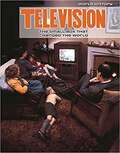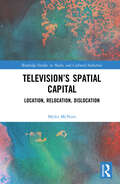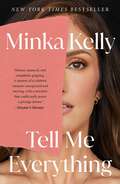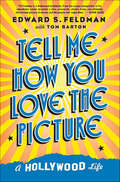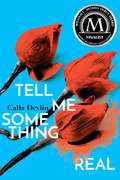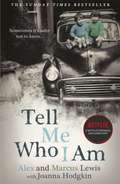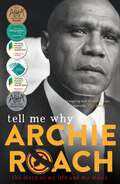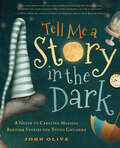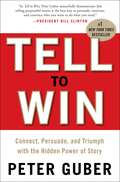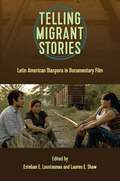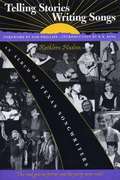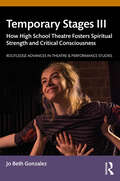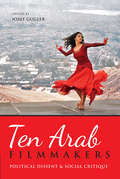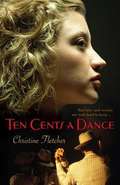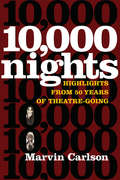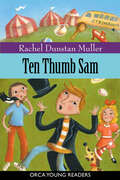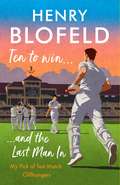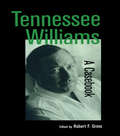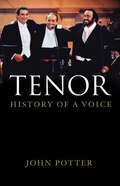- Table View
- List View
Television: The Small Box that Changed the World (World History)
by Katie KawaIt is sometimes said that we are living in a Golden Age of television. What does that mean, and how did we get there? Readers find the answers as they trace the history of television, from its invention to the current age of Peak TV. <p><p> This fascinating story is presented to readers through informative main text, annotated quotations, detailed sidebars, primary sources, and a comprehensive timeline. Television has changed nearly every aspect of life in many countries, and readers are sure to be excited by this fun and fact-filled look at how history and television have influenced each other.
Television: Visual Storytelling and Screen Culture (Routledge Communication Ser.)
by Jeremy G. ButlerFor over two decades, Television has served as the foremost guide to television studies, offering readers an in-depth understanding of how television programs and commercials are made and how they function as producers of meaning. Author Jeremy G. Butler shows the ways in which camera style, lighting, set design, editing, and sound combine to produce meanings that viewers take away from their television experience. Highlights of the fifth edition include: An entirely new chapter by Amanda D. Lotz on television in the contemporary digital media environment. Discussions integrated throughout on the latest developments in screen culture during the on-demand era—including the impact of binge-watching and the proliferation of screens (smartphones, tablets, computer monitors, etc.). Updates on the effects of new digital technologies on TV style.
Television’s Spatial Capital: Location, Relocation, Dislocation (Routledge Studies in Media and Cultural Industries)
by Myles McNuttThis book launches a comprehensive detailing of the dramatic expansion of the geography of television production into new cities, states, provinces, and countries, and how those responsible for shaping the "landscape" of television have been forced to adapt, taking established strategies for engaging with space and place through mediated representation and renegotiating them to account for the new map of television production. Modeling media studies research that considers the intersection of production, textuality, distribution, and reception, Myles McNutt identifies how the expansion of where television is produced has intersected with the kinds of places represented on television, and how shifts in the production, distribution, and consumption of television content have shifted the burden of representing cities and countries both locally and internationally. Through a combination of industry interviews, textual analysis, and in-depth consideration of industry and audience discourse, the book argues that where television takes place matters more today than it ever has, but that the current system of spatial capital remains constrained by traditional industry logics that limit the depth of engagement with place identity even as the expectation of authenticity grows significantly. Representing a cross section of media industry studies, television studies, and cultural geography, this book will appeal to scholars and students within multiple areas of media studies, including production studies and audience studies, in addition to television studies broadly.
Tell Me Everything: A Memoir
by Minka KellyNEW YORK TIMES BESTSELLERA Washington Post best celebrity memoir of 2023An Audible best celebrity memoir of 2023“A timely, urgent portrait of working-class American women.”—Gabrielle UnionIn her highly anticipated memoir Tell Me Everything, Minka Kelly shares a story as powerful as it is page-turning.Fans know her as the spoiled, rich cheerleader Lyla Garrity on Friday Night Lights or as the affluent, mysterious Samantha on the HBO megahit Euphoria. But as revealed for the first time in these pages, Minka Kelly’s life has been anything but easy.Raised by a single mother who worked as a stripper and struggled with addiction, Minka spent years waking up in strange apartments as she and her mom bounced around the country, relying on friends and relatives to take them in. At times they even lived in storage units. She reconnected with her father, Aerosmith’s Rick Dufay, and eventually made her way to Los Angeles, where she landed the role of a lifetime on Friday Night Lights.Now an established actress and philanthropist, Minka takes this next step in her career as a writer. She has poured her soul into the pages of this book, which ultimately tells a story of triumph over adversity, and how resilience and love are all we have in the end.
Tell Me How You Love the Picture: A Hollywood Life
by Edward S. Feldman Tom BartonEdward S. Feldman's legendary career began in advertising and publicity at 20th Century-Fox in the 1950s, and from there he worked his way up to executive studio positions within Seven Arts, Filmways, and Warner Brothers. Following this, he has spent the last twenty-five years as a successful, Academy Award-nominated film producer.Ed's unique story takes readers on a more than fifty-year journey through Hollywood that few can tell--and most will never forget. With tales from the set of Whatever Happened to Baby Jane? to why a well-known actor trashed Ed's office and why a major Hollywood mogul tried to turn all of Tinseltown against one of Ed's films, readers will learn what it takes to produce a film and survive the jungles of Hollywood, laughing all the way.Tell Me How You Love the Picture is a smartly written, surprising, hilarious memoir that takes us behind the scenes with wild, no-holds-barred stories about major Hollywood personalities ranging from Bette Davis to Elizabeth Taylor, Stanley Kubrick to Scott Rudin, Harrison Ford to Jim Carrey to Eddie Murphy and more. As a top studio exec and one of Hollywood's most respected producers, Feldman has seen the film business from the inside out, worked with some of the best talent in the industry, and experienced things few can imagine.An incredible Hollywood memoir from one of moviedom's renowned producers, Tell Me How You Love the Picture is full of insight and the stuff of gossip, bad behavior, and high success.
Tell Me No Lies (Follow Me Back #2)
by A. V. GeigerRealEricThorn No one knows what happened to pop icon Eric Thorn. His Twitter account? Frozen. His cell phone? Cracked and bloody, buried in the snow. Snowflake734Tessa Hart knows the truth, but she's finally left her #EricThornObsessed days behind. She has no intention of ever touching her Twitter app again. But SnapChat...That's safer, right? Agoraphobic fangirl Tessa Hart has finally left her house—only to trade one hiding place for another. But she can only stay out of sight for so long before she's forced to face the deadly consequences of the past. Back in an interrogation room, answers only lead to more questions in the pulse-pounding conclusion to the Follow Me Back duology.
Tell Me Something Real
by Calla Devlin<p>Three sisters struggle with the bonds that hold their family together as they face a darkness settling over their lives in this masterfully written debut novel. <p>There are three beautiful blond Babcock sisters: gorgeous and foul-mouthed Adrienne, observant and shy Vanessa, and the youngest and best-loved, Marie. Their mother is ill with leukemia and the girls spend a lot of time with her at a Mexican clinic across the border from their San Diego home so she can receive alternative treatments. <p>Vanessa is the middle child, a talented pianist who is trying to hold her family together despite the painful loss that they all know is inevitable. As she and her sisters navigate first loves and college dreams, they are completely unaware that an illness far more insidious than cancer poisons their home. Their world is about to shatter under the weight of an incomprehensible betrayal...</p>
Tell Me Who I Am: The Story Behind the Netflix Documentary
by Joanna Hodgkin Alex And Marcus LewisThe story behind the hit Netflix documentary: The bestselling account of the bond between brothers and the shocking legacy of a dangerous mother.Imagine waking up one day to discover that you have forgotten everything about your life. Your only link with the past, your only hope for the future, is your identical twin.Now imagine, years later, discovering that your twin had not told you the whole truth about your childhood, your family, and the forces that had shaped you. Why the secrets? Why the silences? You have no choice but to begin again.This has been Alex's reality: a world where memories are just the stories people tell you, where fact and fiction are impossible to distinguish. With dogged courage he has spent years hunting for the truth about his hidden past and his remarkable family. His quest to understand his true identity has revealed shocking betrayals and a secret tragedy, extraordinary triumph over crippling adversity and, above all, redemption founded on brotherly love.Marcus his twin brother has sometimes been a reluctant companion on this journey, but for him too it has led to staggering revelations and ultimately the shedding of impossible burdens. Their story spans continents and eras, from 1950s debutantes and high society in the Home Counties to a remote island in the Pacific and 90s raves. Disturbing, funny, heart-breaking and affirming, Alex and Marcus's determination to rebuild their lives makes us look afresh at how we choose to tell our stories.
Tell Me Why: The Story of My Life and My Music
by Archie RoachA powerful memoir of a true Australian legend: stolen child, musical and lyrical genius, and leader. Not many have lived as many lives as Archie Roach – stolen child, seeker, teenage alcoholic, lover, father, musical and lyrical genius, and leader – but it took him almost a lifetime to find out who he really was. Roach was only two years old when he was forcibly removed from his family. Brought up by a series of foster parents until his early teens, his world imploded when he received a letter that spoke of a life he had no memory of. In this intimate, moving and often shocking memoir, Archie&’s story is an extraordinary odyssey through love and heartbreak, family and community, survival and renewal – and the healing power of music. Overcoming enormous odds to find his story and his people, Archie voices the joy, pain and hope he found on his path through song to become the legendary singer-songwriter and storyteller that he is today – beloved by fans worldwide.Tell Me Why is a stunning account of resilience and the strength of spirit – and of a great love story.Winner of the 2020 Indie Book of the Year Non-FictionWinner of the 2021 Victorian Premier&’s Literary Award for Indigenous WritingShortlisted for the 2020 ABIA Biography Book of the YearShortlisted for the 2020 Victorian Premier&’s Literary Awards, Non-FictionShortlisted for the Booksellers' Choice 2020 Book of the Year Awards, Non-Fiction Archie Roach was the 2020 VIC Australian of the Year 'Tell Me Why is an extraordinary odyssey and offering. Archie has come through snares, pits and suffering to bring us an inspiring tale of survival, grace and generosity. This book should be in every school.' Paul Kelly &‘Just like his early songs, Tell Me Why was written with empathy as its impetus and that intent shines through on every page. This is a phenomenal work by one of the most articulate and recognisable members of the Stolen Generations. It will be read, studied and discussed for many years to come.&’ The Australian &‘Beautiful, gut-wrenching and compelling memoir&’ Sydney Morning Herald &‘Archie&’s deeply resonant voice sings out – of a broken country and a life renewed. The voice of Australia.&’ Daniel Browning, ABC journalist and producer &‘Roach is honest and humble in his oft-heartbreaking retelling of his search for identity, belonging and purpose&’ Courier Mail &‘Best book of 2019: Tell Me Why by Archie Roach, a beautifully written autobiography that captures one of the most remarkable lives in Australian music&’ Weekend Australia
Tell Me a Story in the Dark: A Guide to Creating Magical Bedtime Stories for Young Children
by John OliveTonight, don't read your child a story. Instead, dim the light, lie down, and create storytelling magic. Weave a spell that will enchant your child. . .Written by an award-winning playwright, Tell Me A Story In The Dark provides you with every tool you need to tell great and entertaining stories. In a day when parents want to spend more quality time with their children, Tell Me A Story In The Dark:Shows you how to prepare and tell a story.Communicates the enormous benefits—ending the bedtime battle of wills, building vocabulary, making room for effective parenting moments.Provides a treasure trove of stories that parents (and grandparents) can adapt for their children.Teaches you how to make up and tell your own stories.Anyone who loves children will love this book.
Tell to Win: Connect, Persuade, and Triumph with the Hidden Power of Story
by Peter GuberToday everyone -- whether they know it or not -- is in the emotional transportation business. More and more, success is won by creating compelling stories that have the power to move partners, shareholders, customers, and employees to action. Simply put, if you can't tell it, you can't sell it. And this book tells you how to do both. Historically, stories have always been igniters of action, moving people to do things. But only recently has it become clear that purposeful stories -- those created with a specific mission in mind -- are absolutely essential in persuading others to support a vision, dream or cause. Peter Guber, whose executive and entrepreneurial accomplishments have made him a success in multiple industries, has long relied on purposeful story telling to motivate, win over, shape, engage and sell. Indeed, what began as knack for telling stories as an entertainment industry executive has, through years of perspiration and inspiration, evolved into a set of principles that anyone can use to achieve their goals. In Tell to Win, Guber shows how to move beyond soulless Power Point slides, facts, and figures to create purposeful stories that can serve as powerful calls to action. Among his techniques: *Capture your audience's attention first, fast and foremost *Motivate your listeners by demonstrating authenticity *Build your tell around what's in it for them *Change passive listeners into active participants *Use state-of-the-heart technology online and offline to make sure audience commitment remains strong. To validate the power of telling purposeful stories, Guber includes in this book a remarkably diverse number of voices -- master tellers with whom he's shared experiences. They include YouTube founder Chad Hurley, NBA champion Pat Riley, clothing designer Normal Kamali, Mission to Mars scientist Gentry Lee, Under Armour CEO Kevin Plank, former South African president Nelson Mandela, magician David Copperfield, film director Steven Spielberg, novelist Nora Roberts, rock legend Gene Simmons, and physician and author Deepak Chopra. After listening to this extraordinary mix of voices, you'll know how to craft, deliver -- and own -- a story that is truly compelling, one capable of turning others into viral advocates for your goal.
Telling Migrant Stories: Latin American Diaspora in Documentary Film (Reframing Media, Technology, and Culture)
by Esteban E. Loustaunau and Lauren E. ShawIn the media, migrants are often portrayed as criminals; they are frequently dehumanized, marginalized, and unable to share their experiences. Telling Migrant Stories explores how contemporary documentary film gives voice to Latin American immigrants whose stories would not otherwise be heard.The essays in the first part of the volume consider the documentary as a medium for Latin American immigrants to share their thoughts and experiences on migration, border crossings, displacement, and identity. Contributors analyze films including Harvest of Empire, Sin país, The Vigil, De nadie, Operation Peter Pan: Flying Back to Cuba, Abuelos, La Churona, and Which Way Home, as well as internet documentaries distributed via platforms such as Vimeo and YouTube. They examine the ways these films highlight the individual agency of immigrants as well as the global systemic conditions that lead to mass migrations from Latin American countries to the United States and Europe.The second part of the volume features transcribed interviews with documentary filmmakers, including Luis Argueta, Jenny Alexander, Tin Dirdamal, Heidi Hassan, and María Cristina Carrillo Espinosa. They discuss the issues surrounding migration, challenges they faced in the filmmaking process, the impact their films have had, and their opinions on documentary film as a force of social change. They emphasize that because the genre is grounded in fact rather than fiction, it has the ability to profoundly impact audiences in a way narrative films cannot. Documentaries prompt viewers to recognize the many worlds migrants depart from, to become immersed in the struggles portrayed, and to consider the stories of immigrants with compassion and solidarity. Contributors: Ramón Guerra | Lizardo Herrera | Jared List | Esteban Loustaunau | Manuel F. Medina | Ada Ortúzar-Young | Thomas Piñeros Shields | Juan G. Ramos | Lauren Shaw | Zaira Zarza A volume in the series Reframing Media, Technology, and Culture in Latin/o America, edited by Héctor Fernández L'Hoeste and Juan Carlos Rodríguez
Telling Sexual Stories: Power, Change, And Social Worlds
by Ken PlummerThis book explores the rites of a sexual story-telling culture. Taking three major examples - rape stories, coming-out stories, recovery stories - it examines the nature of these newly emerging narratives and the socio-historical conditions which have given rise to them. It looks at the rise of the women's movement, the lesbian and gay movement and the 'recovery' movement as harbingers of significant social change that encourage the telling of new stories.
Telling Stories, Writing Songs: An Album of Texas Songwriters
by Kathleen HudsonWillie Nelson, Joe Ely, Marcia Ball, Tish Hinojosa, Stevie Ray Vaughan, Lyle Lovett . . . the list of popular songwriters from Texas just goes on and on. In this collection of thirty-four interviews with these and other songwriters, Kathleen Hudson pursues the stories behind the songs, letting the singers' own words describe where their songs come from and how the diverse, eclectic cultures, landscapes, and musical traditions of Texas inspire the creative process. Conducted in dance halls, dressing rooms, parking lots, clubs-wherever the musicians could take time to tell their stories-the interviews are refreshingly spontaneous and vivid. Hudson draws out the songwriters on such topics as the sources of their songs, the influence of other musicians on their work, the progress of their careers, and the nature of Texas music. Many common threads emerge from these stories, while the uniqueness of each songwriter becomes equally apparent. To round out the collection, Hudson interviews Larry McMurtry and Darrell Royal for their perspectives as longtime friends and fans of Texas musicians. She also includes a brief biography and discography of each songwriter.
Temporary Stages III: How High School Theatre Fosters Spiritual Strength and Critical Consciousness (Routledge Advances in Theatre & Performance Studies)
by Jo Beth GonzalezTheatre activities ask adolescents to empathize with those who are different from themselves. Recognizing divergence invites self-reflection and kindles compassion. These actions tap students’ inner cores while at the same time deepening their understanding of privilege, a key component of critical consciousness.Through the lens of critical pedagogy and feminist theory, this book explores the mutually reinforcing development of spirituality and emerging critical consciousness fostered by high school theatre experience. By examining her own public high school theatre program through description, analysis and interpretation, Gonzalez explores why and how theatre work can simultaneously fortify teens’ spiritual growth while activating dawning awareness of the socio-political dynamics in their own lives and the world around them. The book includes the original one-act play Free to Fly, which introduces young people to the dangers of sex trafficking of minors.Temporary Stages III will appeal especially to secondary theatre teachers, theatre education pre-service teachers, and graduate students studying theatre pedagogy and critical cultural theory.
Ten Arab Filmmakers
by Josef GuglerTen Arab Filmmakers provides an up-to-date overview of the best of Arab cinema, offering studies of leading directors and in-depth analyses of their most important films. The filmmakers profiled here represent principal national cinemas of the Arab world -- Algeria, Egypt, Lebanon, Morocco, Palestine, and Syria. Although they have produced many of the region's most-renowned films and gained recognition at major international festivals, with few exceptions these filmmakers have received little critical attention. All ten share a concern with giving image and voice to people struggling against authoritarian regimes, patriarchal traditions, or religious fundamentalism--theirs is a cinéma engagé.The featured directors are Daoud Abd El-Sayed, Merzak Allouache, Nabil Ayouch, Youssef Chahine, Mohamed Chouikh, Michel Khleifi, Nabil Maleh, Yousry Nasrallah, Jocelyne Saab, and Elia Suleiman.
Ten Cents a Dance
by Christine FletcherWith her mother ill, it's up to fifteen-year-old Ruby Jacinski to support her family. But in the 1940s, the only opportunities open to a Polish-American girl from Chicago's poor Yards is a job in one of the meat packing plants. Through a chance meeting with a local tough, Ruby lands a job as a taxi dancer and soon becomes an expert in the art of "fishing": working her patrons for meals, cash, clothes, even jewelry. Drawn ever deeper into the world of dance halls, jazz, and the mob, Ruby gradually realizes that the only one who can save her is herself.
Ten Thousand Nights: Highlights from 50 Years of Theatre-Going
by Marvin CarlsonEsteemed scholar and theater aficionado Marvin Carlson has seen an unsurpassed number of theatrical productions in his long and distinguished career. Ten Thousand Nights is a lively chronicle of a half-century of theatre-going, in which Carlson recalls one memorable production for each year from 1960 to 2010. These are not conventional reviews, but essays using each theater experience to provide an insight into the theater and theatre-going at a particular time. The range of performances covered is broad, from edgy experimental fare to mainstream musicals, most of them based in New York but with stops at major theater events in Paris, Berlin, Moscow, Milan, and elsewhere. The engagingly written pieces convey a vivid sense not only of each production but also of the particular venue, neighborhood, and cultural context, covering nearly all significant movements, theater artists, and groups of the late twentieth century.
Ten Thumb Sam (Orca Young Readers)
by Rachel Dunstan MullerSam Stringbini, the youngest son in a family of circus performers, is living every kid's dream, except for the fact that he is no good on the high wire, trapezes freak him out and magic mystifies him. When the Triple Top Circus is threatened by repeated acts of sabotage, Sam is the number one suspect. To clear his name, Sam enlists the help of his cousin, Harriet, and discovers that, while he may never be a sword-swallower or a lion-tamer, he just might be able to save the circus.
Ten to Win . . . And the Last Man In: My Pick of Test Match Cliffhangers
by Henry Blofeld'Is there anything in sport to compare with the sustained excitement of a cricket match, especially a Test match, in which the advantage continually fluctuates one way and then the other, and when the match enters its last few minutes, all four results are still possible?'After entertaining countless radio listeners around the world for decades, who better to convey the breathless drama of a Test match cliffhanger than Henry Blofeld? Now, in Ten to Win . . . and the Last Man In, he has personally selected thirty matches featuring unforgettable finishes and brought them vividly to life again in his own inimitable way.Ranging from the match-winning bowling of F.R. Spofforth against W.G. Grace's England in 1882, via the first tied Test between Benaud's Australia and Worrell's West Indies in 1960, to the never-say-die batting of Ben Stokes in 2019, he picks out the key events and performances of each memorable match and describes them as only he can.Alongside the big-hitting heroics of Jessop in 1902 and Botham in 1981, he revisits less celebrated matches such as South Africa's hard-fought first Test win in 1906, as well as a crucial innings from Denis Compton in 1948 and a match-saving performance by a young Alan Knott in Guyana in 1968 - one of the most exciting matches he has ever witnessed first-hand.Filled with colourful detail and informed by insight gained from a lifetime immersed in the sport he loves, Henry Blofeld's latest book will leave the reader in no doubt - as he himself puts it - about 'what an absurdly irresistible game cricket can be'.
Ten to Win . . . And the Last Man In: My Pick of Test Match Cliffhangers
by Henry Blofeld'Is there anything in sport to compare with the sustained excitement of a cricket match, especially a Test match, in which the advantage continually fluctuates one way and then the other, and when the match enters its last few minutes, all four results are still possible?'After entertaining countless radio listeners around the world for decades, who better to convey the breathless drama of a Test match cliffhanger than Henry Blofeld? Now, in Ten to Win . . . and the Last Man In, he has personally selected thirty matches featuring unforgettable finishes and brought them vividly to life again in his own inimitable way.Ranging from the match-winning bowling of F.R. Spofforth against W.G. Grace's England in 1882, via the first tied Test between Benaud's Australia and Worrell's West Indies in 1960, to the never-say-die batting of Ben Stokes in 2019, he picks out the key events and performances of each memorable match and describes them as only he can.Alongside the big-hitting heroics of Jessop in 1902 and Botham in 1981, he revisits less celebrated matches such as South Africa's hard-fought first Test win in 1906, as well as a crucial innings from Denis Compton in 1948 and a match-saving performance by a young Alan Knott in Guyana in 1968 - one of the most exciting matches he has ever witnessed first-hand.Filled with colourful detail and informed by insight gained from a lifetime immersed in the sport he loves, Henry Blofeld's latest book will leave the reader in no doubt - as he himself puts it - about 'what an absurdly irresistible game cricket can be'.
Ten to Win . . . And the Last Man In: My Pick of Test Match Cliffhangers
by Henry Blofeld'Is there anything in sport to compare with the sustained excitement of a cricket match, especially a Test match, in which the advantage continually fluctuates one way and then the other, and when the match enters its last few minutes, all four results are still possible?'After entertaining countless radio listeners around the world for decades, who better to convey the breathless drama of a Test match cliffhanger than Henry Blofeld? Now, in Ten to Win . . . and the Last Man In, he has personally selected thirty matches featuring unforgettable finishes and brought them vividly to life again in his own inimitable way.Ranging from the match-winning bowling of F.R. Spofforth against W.G. Grace's England in 1882, via the first tied Test between Benaud's Australia and Worrell's West Indies in 1960, to the never-say-die batting of Ben Stokes in 2019, he picks out the key events and performances of each memorable match and describes them as only he can.Alongside the big-hitting heroics of Jessop in 1902 and Botham in 1981, he revisits less celebrated matches such as South Africa's hard-fought first Test win in 1906, as well as a crucial innings from Denis Compton in 1948 and a match-saving performance by a young Alan Knott in Guyana in 1968 - one of the most exciting matches he has ever witnessed first-hand.Filled with colourful detail and informed by insight gained from a lifetime immersed in the sport he loves, Henry Blofeld's latest audiobook will leave the listener in no doubt - as he himself puts it - about 'what an absurdly irresistible game cricket can be'.(P) 2021 Hodder & Stoughton Limited
Tennessee Williams: A Casebook
by Robert F. GrossTennessee Williams' plays are performed around the world, and are staples of the standard American repertory. His famous portrayals of women engage feminist critics, and as America's leading gay playwright from the repressive postwar period, through Stonewall, to the growth of gay liberation, he represents an important and controversial figure for queer theorists. Gross and his contributors have included all of his plays, a chronology, introduction and bibliography.
Tenney Shares the Stage: Tenney Grant, Book 3) (Tenney Grant #3)
by Kellen HertzTenney & Logan are a harmonious match onstage, but behind the scenes, they are totally out of tune. In this third novel, Tenney has signed a recording contract and is ready to make the album of her dreams . . . she just wishes she didn't have to do it with moody Logan Everett! They're supposed to be songwriting partners, but Logan doesn't even seem to be trying. Just when it looks like they've found their harmony, Logan suddenly disappears, and Tenney wonders if he has bailed on their act. A couple of months ago, Tenney would have gladly taken the opportunity to go solo. But as she learns more of Logan's story, she begins to wonder: Do she and Logan need each other--and their music--now more than ever before?
Tenor: History of a Voice
by John PotterFrom its emergence in the sixteenth century to the phenomenon of the "Three Tenors" and beyond, the tenor voice has grown in popularity and esteem. This engaging and authoritative book--the first comprehensive history of tenor singing--presents fascinating details about the world's great performers, styles of singing in different countries, teachers and music schools, the variety of compositions for the tenor voice, and much more. John Potter begins by surveying the prehistory of the tenor in the medieval period, when Gregorian chant and early polyphony had implications for a voice-type, and proceeds to the sixteenth century, when singers were first identified as tenors. He focuses on many of the greatest tenors-- those who predated the gramophone as well as those whose recorded voices may still be heard--and considers the ways in which each is historically significant. The names range from legendary early figures like Ludwig Schnoor von Carolsfeld (Wagner's first Tristan) to those more familiar like Enrico Caruso, Richard Tauber, Mario Lanza, Roberto Alagna, Ian Bostridge, Andrea Bocelli, Il Divo, and, of course, Pavarotti, Domingo, and Carreras. Admirers of the tenor voice will especially appreciate the book's unique reference section, with bibliographical and discographical/video information on several hundred tenors.
